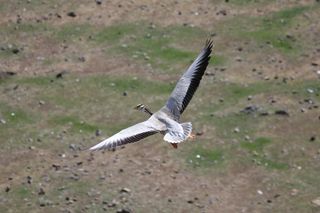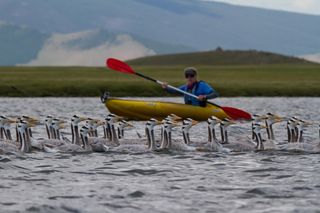Roller-Coaster Flight: How Geese Save Energy While Migrating

Every year, flocks of geese fly hundreds of miles over the Himalayas, migrating from their breeding grounds in Mongolia to southeastern Tibet or India for the winter. Now, a new study reveals how these maverick aviators fly so far in the thin mountain air.
Researchers implanted tracking devices in seven bar-headed geese that measured the animals' heart rate, altitude and other parameters. They found that the birds did not remain at a certain altitude for the duration of their flights, and instead, the geese climbed and descended with the contours of the terrain below.
This flight strategy resembling a roller coaster may allow the birds to conserve energy while flying, the researchers said. [Quest for Survival: Incredible Animal Migrations]
"The logical assumption is, they would spend a lot of time flying very high," said Charles Bishop, a zoologist at Bangor University in the U.K., and co-author of the study published today (Jan. 15) in the journal Science. But "when we went to measure it, we found they seldom seemed to be that high above the ground," he said.
Scientists have long speculated about how bar-headed geese (Anser indicus) make their incredible journey at altitudes above about 20,000 feet (6,000 meters), but no one had actually measured the birds' in-flight physiology, the researchers said.
In the study, Bishop and his colleagues implanted sensors into the geese's abdomens. The implants didn't harm the birds, and they were removed the following year, Bishop told Live Science.
Previously, it was assumed that these geese fly up, above the mountains, then level off at a high cruising altitude, before eventually descending to Earth.
Sign up for the Live Science daily newsletter now
Get the world’s most fascinating discoveries delivered straight to your inbox.
It might seem like the geese's actual strategy, of ascending and descending with the terrain, would burn up more energy than flying at a constant altitude. But in fact, the low density of the air at the higher altitudes over the Himalayas requires that the birds expend even more energy to produce lift, so they are better off descending a bit and then climbing back up, Bishop said.
Another advantage to descending is that more oxygen is available at lower altitudes, which relieves some of the demand on the birds' bodies as they fly, Bishop said.

The tracking data also showed that the birds flapped their wings more frequently at higher altitudes, where the air is less dense. But more important, a small increase in the wingbeat frequency was strongly correlated with a large increase in the heart rate. For example, a 5 percent increase in the wingbeat rate produced a 19 percent change in the birds' heart rate, Bishop said.
This all suggests that as the birds increased their altitude, they had to flap their wings harder to generate the same amount of lift, and this used up a lot of energy. Thus, it makes more sense for the birds to swoop down to lower altitudes when the ground dips down, Bishop explained.
There might be other reasons for the geese to fly low to the ground. It's easier to stop for a drink or to navigate by terrain landmarks, Bishop said.
Of course, not all birds fly low over mountains — some fly at high altitude to take advantage of the tailwinds, whereas others, such as cranes, tend to glide during flight. "It would be fascinating to look at other [high-altitude] birds," Bishop said.
Follow Tanya Lewis on Twitter. Follow us @livescience, Facebook & Google+. Original article on Live Science.

